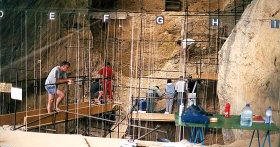Fields of Anthropology
There are now four major fields of anthropology: biological anthropology, cultural anthropology, linguistic anthropology, and archaeology. Each focuses on a different set of research interests and generally uses different research techniques. The methods range from those commonly used by the social sciences and humanities to those of biology and geology. Biological anthropology and archaeology are generally the closest to the biological and physical sciences in methods and approach to learning about the human experience.
A brief look at the 4 main fields of anthropology To return here, you must
click the "back" button on your browser program. (length = 47 secs)
(closed caption version)
Biological AnthropologyBiological (or physical) anthropologists carry out systematic studies of the non-cultural aspects of humans and near-humans. Non-cultural refers to all of those biological characteristics that are genetically inherited in contrast to learned. Near-human is a category that includes monkeys, apes, and the other primates as well as our fossil ancestors. The primary interest of most biological anthropologists today is human evolution--they want to learn how our ancestors changed through time to become what we are today. Biological anthropologists also are interested in understanding the mechanisms of evolution and genetic inheritance as well as human variation and adaptations to different environmental stresses, such as those found at high altitudes and in environments that have temperature extremes.
Biological anthropologists are usually involved in one of three different areas of research: human biology, primatology, or paleoanthropology. Human biology is concerned with learning about human diversity, genetic inheritance patterns, non-cultural adaptations to environmental stresses, and other biological characteristics of our species, Homo sapiens. Primatologists
carry out non-human primate studies. This is usually done in a natural setting among wild apes, monkeys, and related animals. They are principally interested in learning about the capabilities and behavior patterns of primates--our closest living relatives. It is likely that the great apes in particular can give us important clues to understanding the lives of our earliest human ancestors over 2 million years ago. Paleoanthropologists
recover the fossil record of early humans and their primate ancestors in order to understand the path of our evolution. In doing this, they often work with geologists, paleozoologists, and scientists with other specialties who help them reconstruct ancient environments.
Paleoanthropologists searching for fossils and artifacts of our distant human
ancestors in a French cave
Introduction to biological anthropology--what biological anthropologists
study. To return here, you must click the "back" button on your browser
program. (length = 3 mins, 45 secs) (closed caption version)
Cultural Anthropology
Cultural (or socio-cultural) anthropologists are interested in learning about the cultural aspects of human societies all over the world. They usually focus their research on such things as the social and political organizations, marriage patterns and kinship systems, subsistence and economic patterns, and religious beliefs of different societies. Most cultural anthropologists study contemporary societies rather than ancient ones. Through the 19th and most of the 20th centuries, the peoples who primarily interested cultural anthropologists were those who lived in small-scale, isolated societies with cultures that were very different from those of Europeans and European Americans. African, American Indian, and Pacific Island societies were often the subject of their research. Today, they are equally likely to study subcultures of modern, large-scale societies such as Southeast Asian Hmong families now living in St. Paul, Minnesota, Mexican neighborhoods in Southern California, or conservative Old Order Amish communities in rural Pennsylvania.
An American subculture--the Old Order Amish of rural Pennsylvania
Doing cultural anthropology--ethnographic fieldwork in 21st century America.
To return here, you must click the "back" button on your browser program.
(length = 8 mins, 14 secs)We are living in a period of unprecedented social and cultural change around the globe, and the rate of change is accelerating as a result of our rapid population growth and technological invention, especially in transportation and communication. All of the completely isolated societies of the past have long since been drawn into the global economy and heavily influenced by the dominant cultures of the large nations. As a consequence, it is likely that 3/4 of the languages in the world today will become extinct as spoken languages by the end of the 21st century. Many other cultural traditions will be lost as well. Cultural and linguistic anthropologists have worked diligently to study and understand this diversity that is being lost.
Linguistic Anthropology

An example of nonverbal communication in
modern American culture. What do you think
the chief petty officer (in khaki) is communicating
non-verbally to the sailor in this scene?Linguistic anthropologists
study the human communication process. They focus their research on understanding such phenomena as the physiology of speech, the structure and function of languages, social and cultural influences on speech and writing, nonverbal communication, how languages developed over time, and how they differ from each other. This is very different from what goes on in an English or a foreign language class. Linguists are not language teachers or professional translators.
Most anthropological linguistic research has been focused on unwritten, non-European languages. Linguists usually begin their study of such a language by learning first hand from native speakers what its rules are for making sounds and meaning from those sounds, including the rules for sentence construction. Linguists also learn about different regional and social dialects as well as the social conventions of speaking the language in different situations.
A hotly debated question in linguistic anthropology since the early 20th century centers on whether or not our languages predispose us to see the environment in specific ways. In other words, are languages filters for reality? For instance, if a language does not have a word for the color orange, can its speakers distinguish orange from red and yellow? The answer to this question is not as simple as it initially seems.
ArchaeologyArchaeologists are interested in recovering the prehistory and early history of societies and their cultures. They systematically uncover the evidence by excavating, dating, and analyzing the material remains left by people in the past. Archaeologists are essentially detectives who search through many thousands of pieces of fragmentary pots and other artifacts as well as environmental data in order to reconstruct ancient life ways. In a sense, this makes archaeology the cultural anthropology of the past. Archaeology is also related to biological anthropology in its use of the same methods in excavating and analyzing human skeletal remains found in archaeological sites.
Archaeologists are in a unique position to understand the development of human societies and cultures from those of our distant hunter gatherer ancestors through the ancient civilizations on up to the present. There have been humans for at least 2.5 million years. Only the last 5,500 of these years have been even partly recorded by scribes and historians. As a consequence, well over 99% of the human story lies in the prehistoric past and has been out of reach of historians. Only archaeology can recover it.
A Day in the Life: Archaeologists--the work do they do and their education to prepare for it.
To return here, you must click the "back" button on your browser program.
(length = 1 min, 42 secs) (closed caption version)No archaeologist is an expert on the antiquity of all regions of the world and all time periods. Classical archaeologists concentrate on the ancient civilizations of the Middle East and the Mediterranean world (Egypt, Mesopotamia, Greece, Rome, and related peoples). Historical archaeologists work on recovering the unrecorded aspects of life in historically more modern societies such as colonial America. Prehistoric archaeologists focus their attention on the more ancient pre-literate societies around the world including those of most early North American Indians. Underwater archaeologists discover and excavate ancient shipwrecks and submerged cities. Zooarchaeologists
analyze and interpret the animal remains found in archaeological sites. The training required for each of these and other archeological specialties varies significantly, but they all share an interest in elucidating the lost past.
Archaeologists mapping and
excavating an ancient building
in RomeArchaeologist at work in
a radiocarbon dating labUnderwater archaeologist
diving on a shipwreck
NOTE: In British universities, archaeology is usually considered to be a separate academic discipline, distinct from anthropology. This is particularly true of classical and historical archaeology.
The Application of Anthropological Knowledge and MethodsMost anthropologists carry out research and teach about what they have learned. They are employed by universities, colleges, and museums. However, a third of all anthropologists use this knowledge and methodology of problem solving for practical purposes in corporations, government agencies, non-governmental organizations, medical institutions, and other non-academic settings. They are applied anthropologists. It is likely that there will be continued growth in the number of these non-academic jobs.
Some applied cultural anthropologists work as researchers, administrators, implementers, or mediators in major corporations. They help the companies understand and deal more efficiently with employees and customers from diverse cultures and subcultures. There have even been anthropologists working in the White House and U.S. Congress studying the overall operations and personal interactions. In recent years, some cultural anthropologists have worked for the U.S. military and NATO in Afghanistan to help them better understand the cultural realities of the peoples of that region. A few cultural anthropologists have been hired by Native American tribes and other indigenous groups to help them with community development and to advise them in their interactions with the outside world.
Many archaeologists in the United States and some other countries apply their skills in cultural resource management specialist jobs. They are employed by the National Park and Forest Services, the U.S. military, and other government agencies as well as private companies to prevent or mitigate the destruction of archaeological sites and other important cultural resources. They record the locations of unknown archaeological sites and carry out sample excavations to determine their cultural significance and to recommend measures for preservation or further study before they are destroyed by construction projects.
Forensic anthropologists
are employed around the world principally by police, courts, and international organizations to identify murder and disaster victims. They do this mostly from skeletal remains and DNA. Forensic anthropologists also work for the U.S. military to recover and identify the remains of soldiers.
Forensic anthropologist sifting for human bone fragments at a World
Forensic anthropology--lecture/slide show on the work of forensic anthropologists.
To return here, you must click the "back" button on your browser program.
(length = 6 mins, 20 secs)

Many drugs used in modern Western
medicine were derived from plants
used by folk curers. Ethnobotanists
help discover new ones.Medical anthropologists learn about cultural differences in explaining what causes illness and what people from different cultures believe is acceptable as treatment. The germ theory and the idea that illness is not due to supernatural causes are widely accepted by educated people in the Western World and areas that have adopted our medical system. However, much of the rest of the world has very different explanations. Medical anthropologists can help doctors and nurses understand how to better communicate with and treat patients who hold these other explanations. Medical anthropologists also are interested in the epidemiology of illnesses--that is their causes and how they can be cured or controlled.
Some cultural anthropologists work with indigenous peoples in out of the way parts of the globe, such as the Amazon Basin, in order to discover unknown plants and their uses. These researchers are ethnobotanists
. Some of them concentrate on finding new potential medicines from among the plants used by these peoples.
Copyright 2009-2012 by Dennis O'Neil.
All rights reserved.
illustration credits





